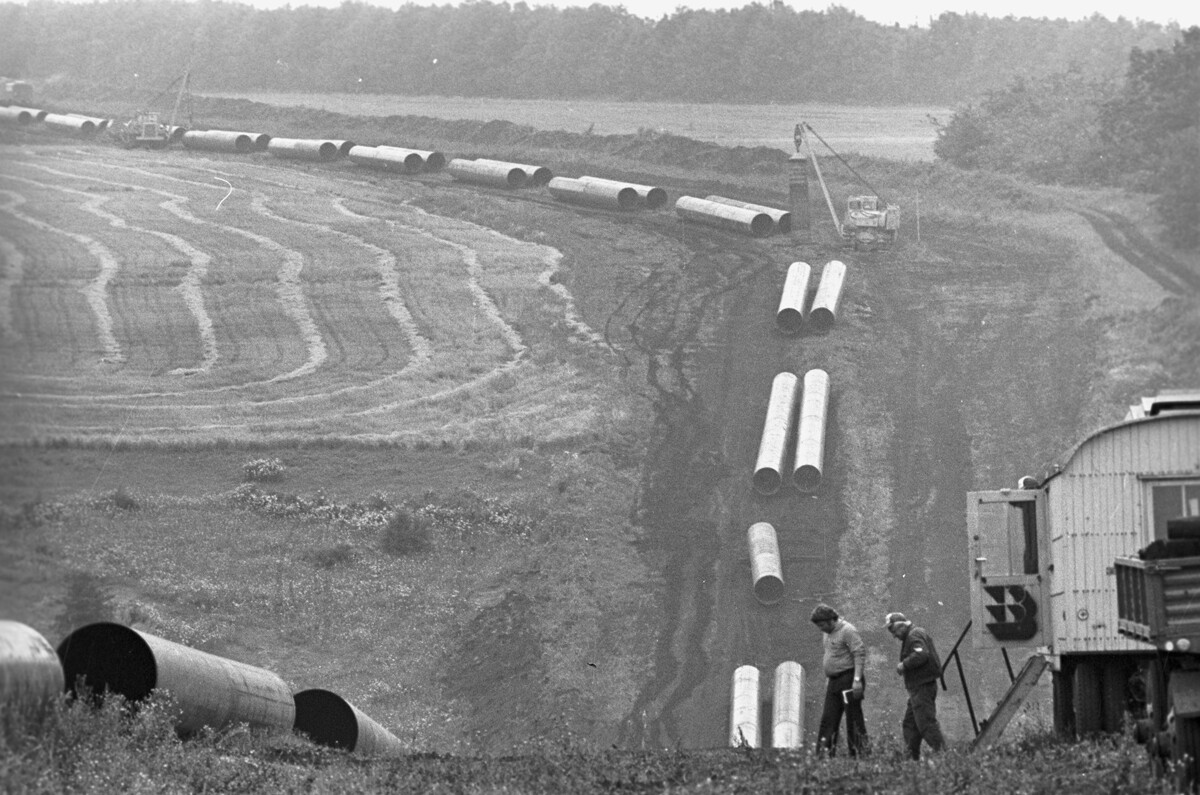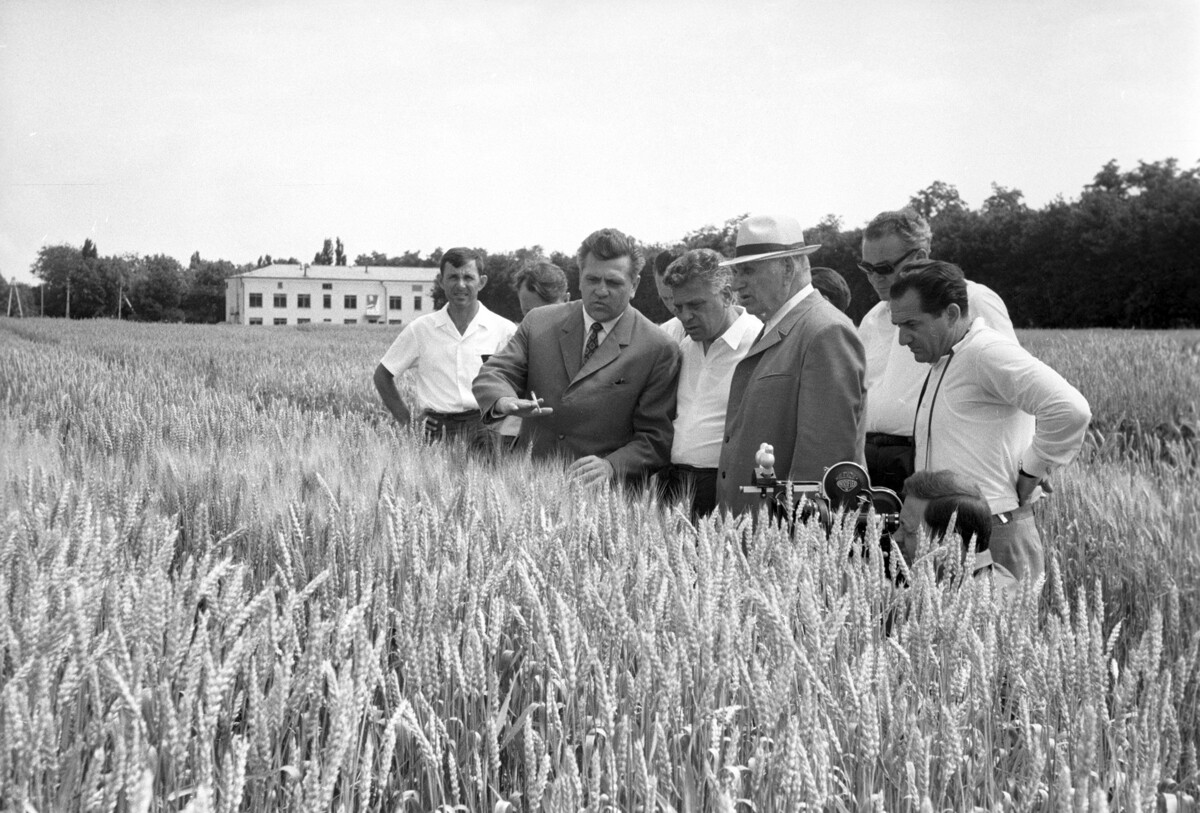How the USSR traded with the West despite the Iron Curtain

“So much extra for your money with Moskvich 4-door saloons and estate!” promises an ad for the Soviet car Moskvich 408 (also called Scaldia 408) that was published in the July 1968 issue of the British magazine Autocar.

Despite the very tense relations during the Cold War, the USSR was quite active trading with the West. Besides the auto industry, photography equipment was another successful Soviet export. The Zenit camera was a big hit in the UK, the U.S., France, and other European countries (under the brands Cosmorex, Kalimar, Spiraflex, Phokina).
For the most part, however, Soviet consumer goods were not widely sold overseas. In the end, the main Soviet export products were natural resources, such as oil and gas. The trade deal, known as “gas in exchange for pipes”, began a long-term energy partnership with Europe. The USSR, for example, imported foreign equipment for the construction of major railroad projects and water canals.
Was there really an Iron Curtain?
 British Prime Minister Winston Churchill speaks at Westminster College in Fulton. March 5, 1946.
British Prime Minister Winston Churchill speaks at Westminster College in Fulton. March 5, 1946.
The “Iron Curtain” cliché coined by British Prime Minister Winston Churchill in 1946 during his Sinews of Peace speech, heralded the beginning of the Cold War between the USSR and Western countries. In 1949, to oppose the UK, the U.S., and their allies, and to maintain close ties with friendly countries in the postwar period, the USSR created the Council for Mutual Economic Assistance (COMECON).
This organization included the countries of the socialist camp: Poland, Bulgaria, Czechoslovakia, Hungary, Romania, and Albania (until 1962), and later was joined by the German Democratic Republic, Mongolia, Cuba, and Vietnam. COMECON members became the USSR’s main trading partners in the second half of the 20th century.
The COMECON members purchased fuel from the USSR – at prices lower than global prices – and supplied the USSR with machinery, equipment, agricultural, industrial, and consumer goods. According to 1960 data, the Soviet Union received 58% of its imports from COMECON members and in turn exported 56% of its goods to them.
In 1956, the First Secretary of the Communist Party of the Soviet Union, Nikita Khrushchev, announced de-Stalinization of the country and a course towards “peaceful coexistence” with the capitalist world. Along with a large Soviet delegation, in 1959 he visited the U.S. where he became acquainted with the latest technological advances in various industries. Some of these, in one way or another, were later implemented in the Soviet Union.
 Soviet leader Nikita Khrushchev and Roswell Garst (an American farmer and seed company executive) pose with corn cobs during an inspection tour of The Garst Farm, Iowa. Khrushchev became the first Soviet leader to visit the U.S. September 23, 1959.
Soviet leader Nikita Khrushchev and Roswell Garst (an American farmer and seed company executive) pose with corn cobs during an inspection tour of The Garst Farm, Iowa. Khrushchev became the first Soviet leader to visit the U.S. September 23, 1959.
Leonid Brezhnev, who replaced Khrushchev in 1964, continued the policy of detente with the industrially developed capitalist countries (the U.S., France, Spain, Italy, Japan, West Germany, and others), all the while maintaining close relations with the COMECON countries. In 1975, along with the heads of 34 countries, including the U.S. and Europe, the USSR signed the Final Act on Security and Cooperation in Europe.
However, relations with the U.S. were strained again in 1979 when Soviet troops deployed to Afghanistan. Nevertheless, by 1986, about 67% of the USSR’s foreign trade came from socialist countries, 22% from capitalist countries, and 11% from developing countries. Export revenues made up 20% of the Soviet state budget.
Soviet exports to the West
 Construction of the Orenburg-Western Frontier gas pipeline (now Soyuz).
Construction of the Orenburg-Western Frontier gas pipeline (now Soyuz).
In the 1970-80s, the USSR became a major fuel exporter to the West – selling oil and natural gas. At that time the economies of European countries were struggling economically and required cheap energy resources.
From 1970 to 1986, the share of gas supplies in the overall Soviet export volume grew from 1% to 15%. In 1970, the USSR signed an agreement with West Germany whereby the latter supplied the USSR with large-diameter pipes and equipment to build a gas pipeline to Western Europe in exchange for gas from Western Siberia.
Despite intense dissatisfaction and vociferous objections from the Americans, this deal became one of the most important in the list of long-term contracts of gas supplies that was signed with the countries of Western Europe (France, Italy, Austria, etc).
While in 1970 natural gas exports totalled 3.3 billion m3, by 1986 they rose to 79.2 billion m3. The share of fuel and power supply in 1986 accounted for 47.3% of overall exports.
Soviet exports in 1986 (in %):
- Fuel and electricity – 47.3%
- Machinery, equipment, and vehicles – 15%
- Ores and concentrates, metals and metal products – 8.4%
- Chemical products, fertilizers, and rubber – 3.5%
- Timber, pulp and paper products – 3.4%
- Industrial consumer goods – 2.4%
- Textile raw materials and intermediate goods – 1.4%
- Food and raw materials for manufacturing – 1.6%
The second significant export category was machinery, equipment, and vehicles. In 1986, it accounted for about 15% of exports.
 Julie Desmond, a 24 year old model, climbs out of the back of a Russian Moskvich 427 car, at a car trade show. 1971.
Julie Desmond, a 24 year old model, climbs out of the back of a Russian Moskvich 427 car, at a car trade show. 1971.
For example, the Moskvitch car made by the MZMA factory (later called AZLK) became famous in Europe after participating in an international car rally in the late 1960s. Consumers in France and the UK began to eagerly buy it. Moskvitchs were also assembled at factories in Bulgaria (under the brand Rila) and in Belgium (under the brand Scaldia).
READ MORE: This is how the USSR sold cars to the West
Soviet vehicles and machinery sales peaked in the 1980s. In 1986, about 306,000 cars, 38,000 trucks, 39,000 tractors, and 2,919 buses were exported.
Military vehicles were also exported in significant numbers – starting in 1971 and right until the fall of the USSR several tens of thousands of military vehicles were exported (tanks, planes, helicopters, etc.).
The USSR supplied the West with power-generating equipment for hydro- and thermal power plants, nuclear reactors, and also sold licenses to manufacture turbines and generators, as well as power plant projects.
The share of other goods, exported during the last decade of the USSR, was noticeably inferior to those categories above, although many Europeans have nostalgic feelings towards the Soviet Zenit camera, the Poljot wristwatch, and the Micro radio receiver.
 British businessmen take a look at the Zenit-6 camera. Moscow, 1968.
British businessmen take a look at the Zenit-6 camera. Moscow, 1968.
Soviet imports from the West
According to data, from 1940 to 1986 more than 30% of Soviet imports were accounted for the purchase abroad of machinery, equipment, and the purchase of various vehicles. In 1986, these already made up 40.7% of total imports.
Soviet imports in 1986 (in %):
- Machinery, equipment, and vehicles – 40.7%
- Food and raw materials for processing – 17.1%
- Industrial consumer goods – 13.4%
- Ores and concentrates, metals and metal products – 8.3%
- Chemical products, fertilizers, and rubber – 5.1%
- Fuel and electricity – 4.6%
- Timber, pulp and paper products – 1.3%
- Textile raw materials and intermediate goods – 1.3%
Machinery and equipment imports
The USSR imported large quantities of electrical, power, and metallurgical equipment from its foreign partners. In addition, the USSR imported metal-cutting machines, jack hammers, train cars, trucks, ships, and much more.
From 1945 to 1991, about 500,000 cars were imported into the USSR. Foreign trucks – Tatra 111, Skoda-LIAZ, Mitsubishi-Fuso, and Komatsu-Nissan – could be spotted at the country’s main construction sites (Volga–Don Canal, Baikal–Amur Mainline).
For many decades, even domestically produced cars remained a luxury item. Only the political elite and members of society’s highest and most inner circles enjoyed foreign cars. While trucks and road equipment made up 3.5% of total imports in 1986, cars, motorcycles, and scooters made up only 0.5%.
How the USSR went from a wheat exporter to a wheat importer
 The Hungarian delegation, headed by Hungarian Minister of Agriculture Istvan Gergey, on the field of the Krasnodar Research Institute of Agriculture. 1972.
The Hungarian delegation, headed by Hungarian Minister of Agriculture Istvan Gergey, on the field of the Krasnodar Research Institute of Agriculture. 1972.
Food was second place on the list of goods imported into the Soviet Union. Due to urbanization and the migration of the population from the villages to the cities, the country faced food shortages. In the beginning of the 1960s some regions utilized food rationing; there were shortages of meat, milk, and grain, as well as other food products.
In the 1960-1980s, according to the book USSR National Economy Over 70 Years, the country regularly imported grain, tea, meat, berries, fruit, and sugar. Import volumes continued to grow. In 1960, the USSR imported 66,000 tons of meat and meat products; in 1980 – more than 900,000 tons; as for fruit and berries, in 1960 it imported 335,000 tons, and in 1980 – 995,000 tons.
As for grain, after World War II the USSR resumed grain exports to Europe, and by 1952 this amounted to 4.5 million tons exported per year. Wanting to increase the volumes, the USSR began the development of virgin lands in Kazakhstan. However, due to the difficult climate, it didn’t yield the expected results.
Besides the fact that grain was needed by the population of the vast country, as well as exported, large volumes also had to be fed to livestock. So, the Soviet government came up with a program to improve domestic production of meat and milk. A campaign was launched to grow corn under the policy of the First Secretary of the Communist Party of the Soviet Union, Nikita Khrushchev; (launched after his trip to the U.S.).
But this also didn’t help despite the fact that a sizable part of the state agricultural budget was spent to plant it. By 1963 the USSR had to begin importing feed grain from the U.S. and Canada. In 1972, import volumes were 23 million tons of grain; in 1980 – 43 million tons.
Consumer goods
 A long queue for sausages. Moscow, 1977.
A long queue for sausages. Moscow, 1977.
Following the death of Joseph Stalin, in the late 1950s the USSR began policies to improve the population’s well-being. Still, there weren’t enough Soviet consumer goods for everyone.
In 1981, the Congress of the Communist Party of the Soviet Union stated that “from year to year the production plans of many types of consumer goods are failing – especially fabrics, knitwear, and leather footwear.” At that time, there was 2.1 knitwear and 3.2 pairs of footwear per capita. The funds earned from exporting energy supplies went to buy leather footwear, knitwear, cotton and silk fabrics, medicines, and more.
Because of the policy of communal apartment resettlement and into separate apartments, there was rising demand for furniture. Soviet citizens dreamed of Czech and Romanian furniture. Buyers lined up in local stores across the country. Despite the growth of imports of consumer goods, the final decade of the USSR is remembered by many Soviet citizens as a time of widespread shortages.

